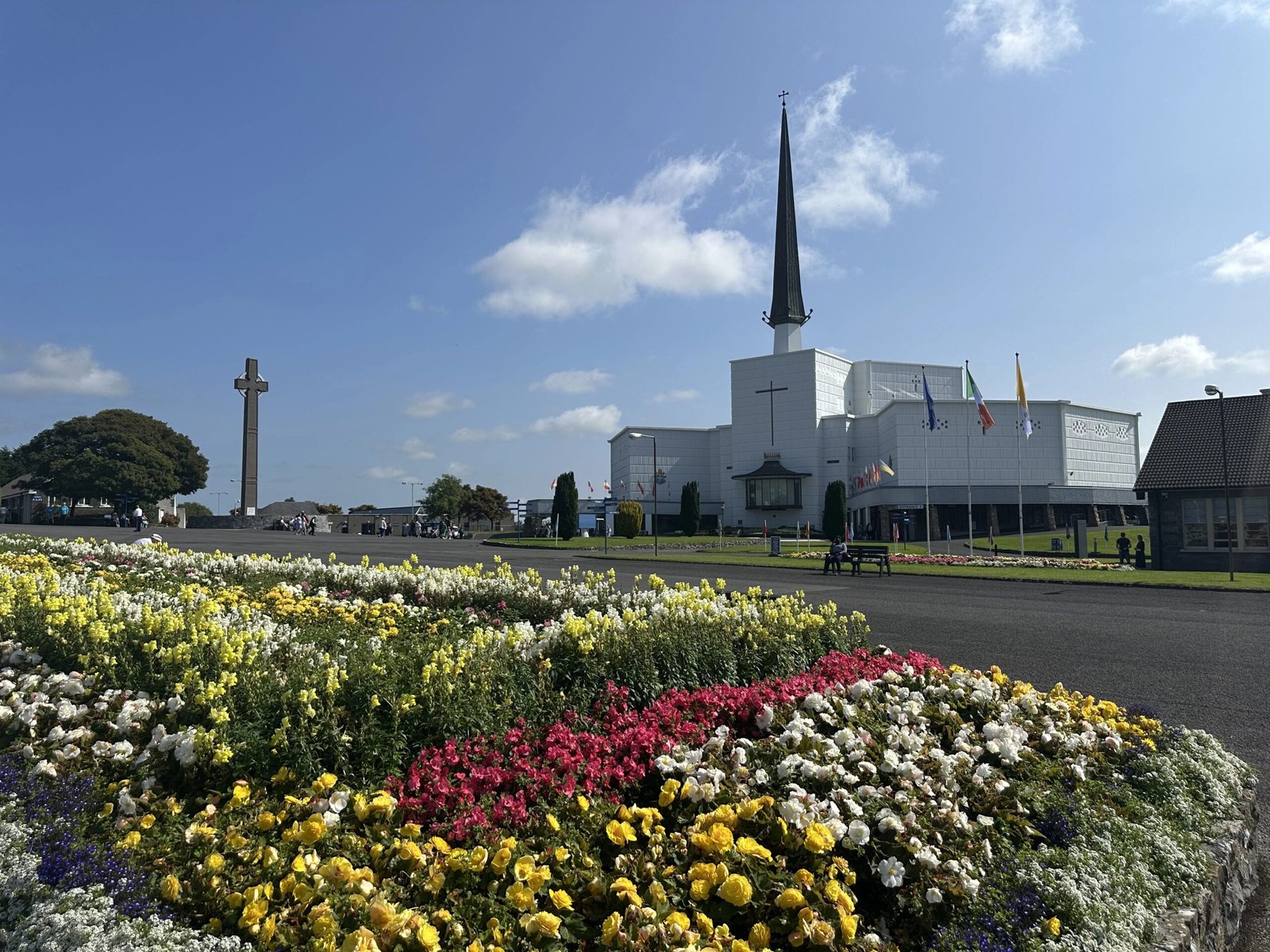Knock, Ireland, Aug 21, 2025 /
13:20 pm
At Ireland’s Knock Shrine, the confessionals are “the engine room,” its rector says, powering this rural Marian apparition site as a place of hope and healing during the jubilee year.
“We have a very, very big outreach here in terms of confessions,” Father Richard Gibbons, who has led the shrine for more than a decade, told CNA on the eve of the 146th anniversary of the only documented apparition of the Blessed Virgin Mary together with St. Joseph and St. John.
In a country where Mass attendance has sharply declined in recent decades, Irish Catholic leaders point to Knock as a place of welcome for those who have fallen away from practicing the faith.

“Sometimes people who are in difficulty with their faith feel, ‘I’m not a good enough Catholic to go to Knock or to Lourdes or to Fátima,’ which is not the case,” Gibbons said. “It’s specifically because you might be struggling that you come to places like this and find hope.”
The shrine has 16 full-time chaplains who hear confessions daily from morning to evening, welcoming thousands, including those who come hesitantly after years away from the sacrament.
“People come and they might have no intention of going to confession,” Gibbons said. “They see people going … they take a chance … and it’s completely transformative for them.”

“They open up and then you let the grace of God work.”
Pilgrimage season peaks each August with the National Novena to Our Lady of Knock, nine days of daily Mass, Eucharistic processions, and candlelit rosaries ending on the anniversary of the apparition on Aug. 21. Gibbons estimates that about 150,000 pilgrims visited the shrine during the novena this year.
The most ‘unique apparition in all the world’
On the rain-soaked evening of Aug. 21, 1879, 15 witnesses in the small village of Knock in County Mayo in western Ireland saw something extraordinary outside of their parish church of St. John the Evangelist: the Blessed Virgin Mary dressed in white robes and a crown with her hands and eyes turned toward heaven in prayer.
To her right was St. Joseph, who had gray hair and a beard, and to her left was St. John vested as a bishop with an open book in his hand. Beside them was a lamb standing on an altar in front of a cross surrounded by angels.

For two hours, despite the downpour, the apparition remained. Fifteen witnesses — men, women and children, the youngest just 5 years old — prayed the rosary before the silent figures. Remarkably, the ground around the church wall stayed dry.
“It’s the most unusual apparition. It’s unique in all the world,” Gibbons said. “At the heart and center is the Eucharist — the altar and the lamb.”
(Story continues below)
Subscribe to our daily newsletter
Unlike most Marian apparitions, Mary said nothing at Knock. Some historians suggest the silence reflected the cultural upheaval of 19th-century Ireland, when older generations still spoke Irish while the young were taught only English under colonial rule. What was clear, Gibbons said, is that the vision came at a time of suffering.

“There was just an awful lot of suffering and pain and violence at the time,” he said. “There was a land war going on with tenants being evicted … and many famines.”
The Great Famine of 1845–1849 devastated Ireland, resulting in the deaths of an estimated 1 million people, with 1 million more emigrating from the country by 1951.
Recurring famines plagued Ireland in the decades that followed, particularly in the northwest County Mayo where the apparition occurred. The year 1879 was itself “a famine year” for the Irish people.
“Our Lady appeared when people needed hope and that connection with heaven,” Gibbons said.
Miracles and healings
Stories of cures have been linked to Knock since the first days after the apparition. Grace Mulqueen, curator of the Knock Museum, tells visitors about the shrine’s earliest miracle: a deaf girl named Delia Gordon who, just 10 days after the apparition, was healed when her mother scraped stone dust from the church’s gable wall and placed it in her ears.
“Her daughter was instantly cured,” Mulqueen said. “And once people began to hear of that cure … then people started to come with their walking sticks and crutches and hundreds of people reported that they were healed or cured.”

By 1880, the local parish priest had documented more than 600 claims of miraculous cures.
The most recent officially recognized miracle was the healing of Marion Carroll, who had long suffered from multiple sclerosis and was brought to Knock on a stretcher in 1989. After being blessed by a monstrance during Eucharistic adoration at Knock, she stood up, healed. The cure was formally recognized in 2019 after 30 years of medical investigation.
Jubilee pilgrim passport
For the 2025 Jubilee Year, the Irish bishops launched a “Pilgrim Passport” encouraging visits to Knock, Croagh Patrick, and Lough Derg. Pilgrims collect stamps at each pilgrimage site they visit.
Lough Derg is the site of the Basilica of St. Patrick and the famed medieval “St. Patrick’s Purgatory” pilgrimage. Croagh Patrick is Ireland’s holiest mountain and where St. Patrick spent 40 days fasting, located one hour away from the Knock Shrine.
“It’s unbelievable the amount of people who come because they had just decided to visit Croagh Patrick because they were touring Mayo and then they picked up the passport,” Nicola Mitchell, director of pastoral planning at the shrine, told CNA.

She added that she has encountered people coming to get their passport stamped who “never would have dreamt of visiting Knock” otherwise.
“And we’re inviting people who would never dream of coming to a place like Knock Shrine, inviting them and saying: There’s a warm welcome for you.”
“And I think that you can’t enter the gate of Knock Shrine without feeling that peace that exists here,” Michell said.
Looking ahead to 2029
Knock has twice drawn papal visits. St. John Paul II made it the focal point of his 1979 trip to Ireland, telling the crowd of 400,000 that visiting Knock was “the goal” of his pilgrimage. Pope Francis came in 2018 and later elevated Knock to the status of International Eucharistic and Marian Shrine.
As the 150th anniversary of the apparition in 2029 approaches, organizers are already preparing. Gibbons hopes Pope Leo XIV might mark the occasion with a visit to Knock, as John Paul did for the 100th anniversary.
“2029 will be a very, very special year,” Gibbons said. “We would love Pope Leo XIV to come, even just to celebrate the anniversary.”





